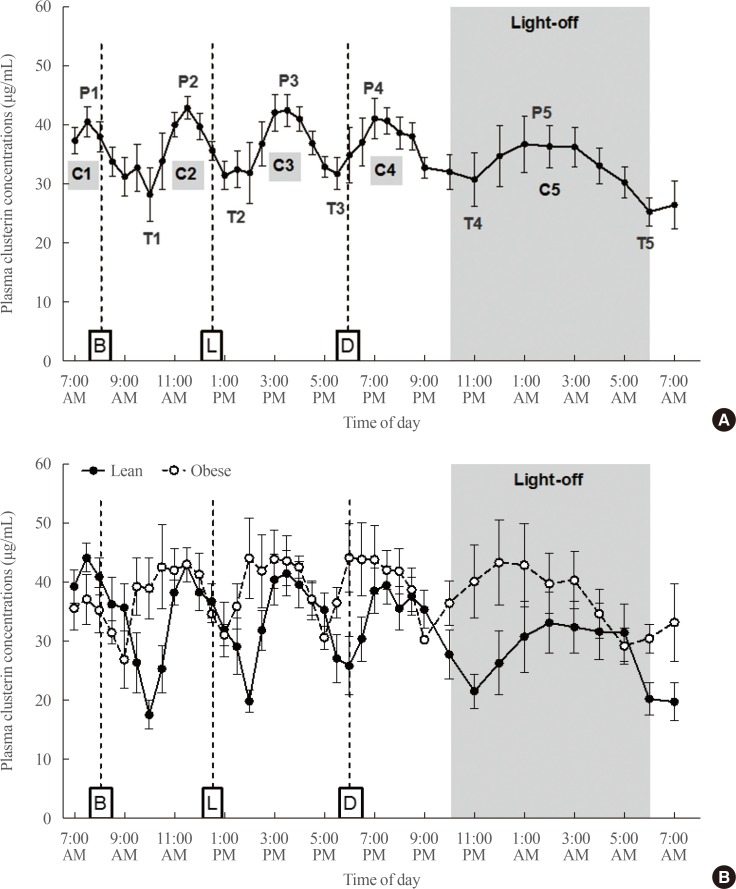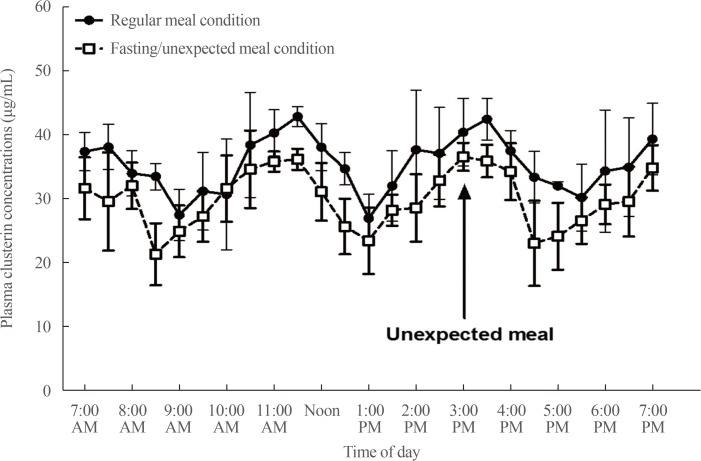Endocrinol Metab.
2018 Jun;33(2):245-251. 10.3803/EnM.2018.33.2.245.
Distinct Ultradian Rhythms in Plasma Clusterin Concentrations in Lean and Obese Korean Subjects
- Affiliations
-
- 1Division of Endocrinology and Metabolism, Department of Internal Medicine, Asan Medical Center, University of Ulsan College of Medicine, Seoul, Korea. mskim@amc.seoul.kr
- 2Division of Endocrinology and Metabolism, Department of Internal Medicine, Veterans Health Service Medical Center, Seoul, Korea.
- 3Osteoneurogen Inc., Seoul, Korea.
- KMID: 2420493
- DOI: http://doi.org/10.3803/EnM.2018.33.2.245
Abstract
- BACKGROUND
Blood levels of many hormones show rhythmic fluctuations with variable duration of cycles. Clusterin/apolipoprotein J is a glycoprotein which is highly expressed in the plasma and has modulatory roles in immune and inflammatory reactions, neurobiology, lipid metabolism, and leptin signaling. In this study, we examined the diurnal fluctuations of plasma clusterin concentrations in lean and obese young men.
METHODS
For the study, 14 subjects (five lean and five obese men; two lean and two obese women) were admitted to the research ward and blood samples were drawn every 30 minutes during light-on period (6:00 AM to 10:00 PM) and every hour during light-off period.
RESULTS
Notably, plasma clusterin concentrations displayed a unique ultradian rhythm with five cycles a day in both men and women. During the light-on period, circulating clusterin levels showed fluctuating curves with 4 hours regular intervals with sharp peaks and troughs. In contrast, single oscillation curve during light-off exhibited a smoothened/lower peak and longer (8-hour) duration. In obese men, these cycles were phase-advanced by approximately 1 hour, and had reduced amplitude of fluctuating curves and blunted diurnal pattern. Cyclic fluctuations of plasma clusterin were preserved under fasting and unexpected meal condition, suggesting that rhythmic oscillations in plasma clusterin levels are not generated by meal-related cues.
CONCLUSION
These findings firstly demonstrate a novel pattern of plasma clusterin fluctuations with extremely regular cycles.
Keyword
MeSH Terms
Figure
Reference
-
1. Martini L. Encyclopedia of endocrine diseases. Amsterdam: Elsevier Academic Press;2004.2. Lambert AE, Hoet JJ. Diurnal pattern of plasma insulin concentration in the human. Diabetologia. 1966; 2:69–72. PMID: 6005292.
Article3. Cummings DE, Purnell JQ, Frayo RS, Schmidova K, Wisse BE, Weigle DS. A preprandial rise in plasma ghrelin levels suggests a role in meal initiation in humans. Diabetes. 2001; 50:1714–1719. PMID: 11473029.
Article4. Sinha MK, Ohannesian JP, Heiman ML, Kriauciunas A, Stephens TW, Magosin S, et al. Nocturnal rise of leptin in lean, obese, and non-insulin-dependent diabetes mellitus subjects. J Clin Invest. 1996; 97:1344–1347. PMID: 8636448.
Article5. Weitzman ED, Fukushima D, Nogeire C, Roffwarg H, Gallagher TF, Hellman L. Twenty-four hour pattern of the episodic secretion of cortisol in normal subjects. J Clin Endocrinol Metab. 1971; 33:14–22. PMID: 4326799.
Article6. Blaschuk O, Burdzy K, Fritz IB. Purification and characterization of a cell-aggregating factor (clusterin), the major glycoprotein in ram rete testis fluid. J Biol Chem. 1983; 258:7714–7720. PMID: 6863260.
Article7. Fritz IB, Burdzy K, Setchell B, Blaschuk O. Ram rete testis fluid contains a protein (clusterin) which influences cell-cell interactions in vitro. Biol Reprod. 1983; 28:1173–1188. PMID: 6871313.8. de Silva HV, Stuart WD, Park YB, Mao SJ, Gil CM, Wetterau JR, et al. Purification and characterization of apolipoprotein J. J Biol Chem. 1990; 265:14292–14297. PMID: 2387851.
Article9. Collard MW, Griswold MD. Biosynthesis and molecular cloning of sulfated glycoprotein 2 secreted by rat Sertoli cells. Biochemistry. 1987; 26:3297–3303. PMID: 3651384.
Article10. Murphy BF, Kirszbaum L, Walker ID, d'Apice AJ. SP-40,40, a newly identified normal human serum protein found in the SC5b-9 complex of complement and in the immune deposits in glomerulonephritis. J Clin Invest. 1988; 81:1858–1864. PMID: 2454950.
Article11. Tobe T, Minoshima S, Yamase S, Choi NH, Tomita M, Shimizu N. Assignment of a human serum glycoprotein SP-40,40 gene (CLI) to chromosome 8. Cytogenet Cell Genet. 1991; 57:193–195. PMID: 1660393.
Article12. Choi-Miura NH, Takahashi Y, Nakano Y, Tobe T, Tomita M. Identification of the disulfide bonds in human plasma protein SP-40,40 (apolipoprotein-J). J Biochem. 1992; 112:557–561. PMID: 1491011.13. Rosenberg ME, Silkensen J. Clusterin: physiologic and pathophysiologic considerations. Int J Biochem Cell Biol. 1995; 27:633–645. PMID: 7648419.
Article14. Viard I, Wehrli P, Jornot L, Bullani R, Vechietti JL, Schifferli JA, et al. Clusterin gene expression mediates resistance to apoptotic cell death induced by heat shock and oxidative stress. J Invest Dermatol. 1999; 112:290–296. PMID: 10084304.
Article15. Zhang H, Kim JK, Edwards CA, Xu Z, Taichman R, Wang CY. Clusterin inhibits apoptosis by interacting with activated Bax. Nat Cell Biol. 2005; 7:909–915. PMID: 16113678.
Article16. Kirszbaum L, Bozas SE, Walker ID. SP-40,40, a protein involved in the control of the complement pathway, possesses a unique array of disulphide bridges. FEBS Lett. 1992; 297:70–76. PMID: 1551440.
Article17. de Silva HV, Stuart WD, Duvic CR, Wetterau JR, Ray MJ, Ferguson DG, et al. A 70-kDa apolipoprotein designated ApoJ is a marker for subclasses of human plasma high density lipoproteins. J Biol Chem. 1990; 265:13240–13247. PMID: 2376594.
Article18. Arnold T, Brandlhofer S, Vrtikapa K, Stangl H, Hermann M, Zwiauer K, et al. Effect of obesity on plasma clusterin, [corrected] a proposed modulator of leptin action. Pediatr Res. 2011; 69:237–242. PMID: 21135756.19. Won JC, Park CY, Oh SW, Lee ES, Youn BS, Kim MS. Plasma clusterin (ApoJ) levels are associated with adiposity and systemic inflammation. PLoS One. 2014; 9:e103351. PMID: 25076422.
Article20. World Health Organization Regional Office for the Western Pacific. The Asia-Pacific perspective: redefining obesity and its treatment. Sydney: Health Communications Australia;2000.
- Full Text Links
- Actions
-
Cited
- CITED
-
- Close
- Share
- Similar articles
-
- Ultradian Rest-activity Rhythms Induced by Quinpirole in Mice Using Wavelet Analysis
- Sleep-Wake Cycles in Man
- Plasma Ghrelin Levels and Its Relationship with Obesity in Obese Children
- Analysis of ultradian rest-activity rhythms using locomotor activity in mice
- Comparison between obese and non-obese nonalcoholic fatty liver disease




